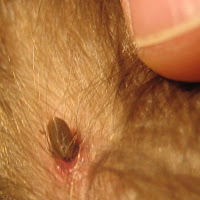Ticks are small arachnids, closely related to the family of mites. They are external parasites which satisfy their nutritional requirements by living on the blood of mammals, birds, and sometimes reptiles and amphibians. Ticks are carriers of a number of diseases, such as Lyme disease, that affect both humans and animals.
For an ecosystem to support ticks, the population density of host species in the area must be high enough, and humidity must be high enough for ticks to remain hydrated.
There are 'soft ticks ' (over 200 species) and 'hard ticks' (over 700 species). The hard ticks have a hard shield, which generally can resist the force of soft-soled footwear, especially on soft ground. It requires a hard sole on a hard surface to crush the tick. However, stepping on an engorged tick, filled with blood, kills it easily, though messily.
Hard ticks will attach to a host and will bite painlessly and generally unnoticed, remaining in place until they engorge and are ready to change their skin; this process may take days or weeks. Some species drop off the host to moult in a safe place, whereas others remain on the same host and only drop off once they are ready to lay their eggs.
Ticks find their hosts by detecting breath and body odors, or by sensing body heat, moisture and vibrations. As they are incapable of flying or jumping, many tick species will wait in a position known as "questing"—holding on to leaves and grass by their third and fourth pair of legs while holding the first pair of legs outstretched, waiting to climb on to the host. When a host brushes the spot where a tick is waiting, it quickly climbs on. Some ticks will attach quickly while others will wander around looking for thinner skin like the ear. Depending on the species and the life stage, feeding preparation can take from ten minutes to two hours. On locating a suitable feeding spot, the tick grasps the skin and cuts into the surface.
 |
| Harpoon-like structure |
With a prominent head that projects forward from the body, ticks extract the blood by piercing a hole in the host's skin, into which they insert a harpoon-like structure near the mouth area, allowing them to anchor themselves firmly in place on a host while sucking blood. This mechanism is normally so strong that removal of a lodged tick requires two actions: One to remove the tick, and one to remove the remaining head section of the tick.
Topical Treatments
Topical flea and tick medicines may be toxic to animals and humans. Phenothrin and methoprene were popular topical flea and tick therapies for cats. Phenothrin kills adult fleas and ticks, while methoprene is an insect growth regulator that interrupts the insect's lifecycle by killing the eggs. However, the EPA required at least one manufacturer of these products to withdraw some products and include strong cautionary statements on others, warning of adverse reactions.
Removal
 |
| Engorged tick attached to child's head. |
In general, the best way to remove an adult tick is to do it manually. First, take a lint roller (not too sticky) and roll it over your dog or cat's fur. You can also use this on your clothing. This should get rid of any small number of tiny 'seed ticks' and fleas. Secondly, to facilitate prompt removal, use fine-tipped tweezers to grasp the tick as close to the skin as possible and detach it by applying a steady upward force without crushing, jerking, or twisting in such a way as to avoid leaving behind mouthparts or provoking release of infective fluids into the wound. It is important to disinfect the bite area thoroughly with rubbing alcohol after removal of the tick. The tick can be stored, in case of signs or symptoms of a subsequent infection, for identification purposes together with details of where and when the bite occurred. If the tick's head and mouthparts are no longer attached to its body after removal, a biopsy may be necessary to remove any parts that have been left behind.
See Also: Natural Flea Repellent for Pets and Natural Insect Repellents
Natural Repellent for Pets
Vinegar - Ticks hate the smell and taste of vinegar, and are easily repelled by it.
In a spray bottle, mix 1 cup of water with 2 cups of white vinegar, and add 2 teaspoons of vegetable oil or almond oil, which contains sulfur (also good for repelling ticks).
Lemon Juice, Citrus, or Peppermint - To make a repellent that will also deter ticks, mix in a few teaspoons of lemon juice, citrus oil, or peppermint oil, any of which will repel ticks and fleas while also creating a pleasant smelling repellent. Spray onto the pet’s dry coat, staying away from sensitive areas such as eyes, nose, mouth, and genitals. When outdoors for an extended period of time, spray this solution on two to three times per day.
Cedar - Cedar oil is a (nontoxic natural substance) which has proven effective in the eradication of infestations in pets. Use of some essential oils containing phenols, such as basil, clove, oregano and thyme, can be hazardous to cats.
Repellent for You and Your Family
In a spray bottle, mix 2 cups of distilled white vinegar and 1 cup of water. To make a scented solution, add 20 drops of your favorite essential oil. Eucalyptus oil is a calm, soothing scent, while peppermint and citrus oils give off a strong crisp scent that also repels fleas.
Shake well to mix, spray onto clothing, skin, and hair before going outdoors. Reapply every four hours. Examine your skin and hair when back inside.
SocialCompare


No comments:
Post a Comment